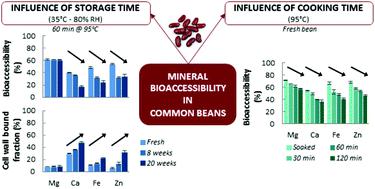当前位置:
X-MOL 学术
›
Food Funct.
›
论文详情
Our official English website, www.x-mol.net, welcomes your feedback! (Note: you will need to create a separate account there.)
The impact of postharvest storage and cooking time on mineral bioaccessibility in common beans.
Food & Function ( IF 6.1 ) Pub Date : 2020-07-30 , DOI: 10.1039/d0fo01302a Sofie Rousseau 1 , Miete Celus 1 , Dorine Duijsens 1 , Shannon Gwala 1 , Marc Hendrickx 1 , Tara Grauwet 1
Food & Function ( IF 6.1 ) Pub Date : 2020-07-30 , DOI: 10.1039/d0fo01302a Sofie Rousseau 1 , Miete Celus 1 , Dorine Duijsens 1 , Shannon Gwala 1 , Marc Hendrickx 1 , Tara Grauwet 1
Affiliation

|
Mineral (Mg, Ca, Fe and Zn) bioaccessibility in common beans was evaluated taking into consideration the common bean food chain from postharvest storage over processing (soaking and cooking) until consumption. Beans were stored under realistic tropical conditions (35 °C and 80% RH) which resulted in significantly different cooking behaviour after 8 weeks compared to freshly harvested beans. Based on postcooking hardness, different storage times were selected: unstored, 8 and 20 weeks. Independently of storage conditions, beans were soaked overnight and cooked for 30, 60 or 120 min. The mineral bioaccessibility decreased with increase in both storage and cooking times. Decrease in mineral bioaccessibility with increasing storage time was proved to be the result of increasing mineral chelation of cell wall polymers (e.g. pectin). Additionally, we hypothesize that by cooking, mineral chelators become more accessible, e.g. through pectin solubilization phenomena, in turn capturing more free minerals leading to a reduced mineral bioaccessibility.
中文翻译:

采后存储和烹饪时间对普通豆类矿物质生物可及性的影响。
评估了普通豆中矿物质(镁,钙,铁和锌)的生物可及性,考虑了从收获后储存到加工(浸泡和烹饪)直至食用的普通豆类食物链。豆类存放在现实的热带条件下(35°C和80%RH),与新鲜收获的豆类相比,在8周后会导致烹饪行为显着不同。根据烹饪后的硬度,选择不同的存储时间:未存储,8周和20周。独立于存储条件,将豆浸泡过夜,然后煮30、60或120分钟。矿物质的生物利用度随储存和烹饪时间的增加而降低。矿物质生物可及性随储存时间的增加而减少,被证明是细胞壁聚合物矿物质螯合增加的结果(例如果胶)。另外,我们假设通过烹饪,例如通过果胶增溶现象,矿物质螯合剂变得更容易获得,进而捕获更多的游离矿物质,从而降低了矿物质的生物利用度。
更新日期:2020-09-23
中文翻译:

采后存储和烹饪时间对普通豆类矿物质生物可及性的影响。
评估了普通豆中矿物质(镁,钙,铁和锌)的生物可及性,考虑了从收获后储存到加工(浸泡和烹饪)直至食用的普通豆类食物链。豆类存放在现实的热带条件下(35°C和80%RH),与新鲜收获的豆类相比,在8周后会导致烹饪行为显着不同。根据烹饪后的硬度,选择不同的存储时间:未存储,8周和20周。独立于存储条件,将豆浸泡过夜,然后煮30、60或120分钟。矿物质的生物利用度随储存和烹饪时间的增加而降低。矿物质生物可及性随储存时间的增加而减少,被证明是细胞壁聚合物矿物质螯合增加的结果(例如果胶)。另外,我们假设通过烹饪,例如通过果胶增溶现象,矿物质螯合剂变得更容易获得,进而捕获更多的游离矿物质,从而降低了矿物质的生物利用度。



























 京公网安备 11010802027423号
京公网安备 11010802027423号